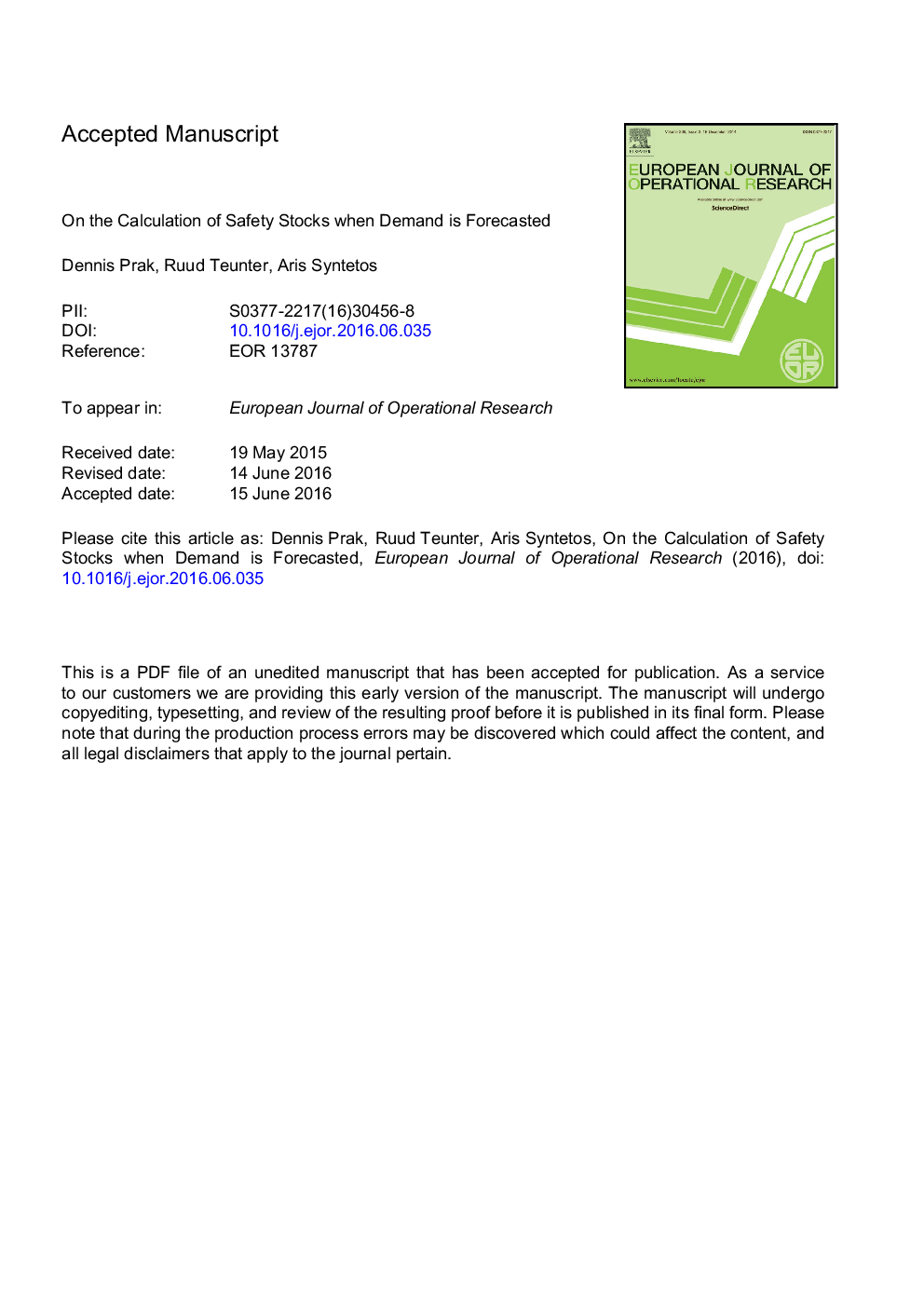| کد مقاله | کد نشریه | سال انتشار | مقاله انگلیسی | نسخه تمام متن |
|---|---|---|---|---|
| 4960220 | 1445968 | 2017 | 24 صفحه PDF | دانلود رایگان |
عنوان انگلیسی مقاله ISI
On the calculation of safety stocks when demand is forecasted
ترجمه فارسی عنوان
در محاسبه سهام ایمنی زمانی که تقاضا پیش بینی می شود
دانلود مقاله + سفارش ترجمه
دانلود مقاله ISI انگلیسی
رایگان برای ایرانیان
کلمات کلیدی
پیش بینی تقاضا، کنترل انبار، سهام ایمنی، عدم اطمینان پیش بینی،
ترجمه چکیده
ادبیات کنترل موجودی به طور کلی فرض می کند که توزیع تقاضا و تمام پارامترهای آن شناخته شده است. در برنامه های کاربردی، اغلب پیشنهاد می شود که واریانس تقاضا را به طور مستقیم یا براساس خطاهای پیش بینی شده ی یک دوره ای پیش بینی کنید. واریانس تقاضای زمان سرب که برای محاسبات سهام ایمنی ضروری است، سپس با ضرب نمودن واریانس تقاضای پیش بینی شده براساس دوره با طول زمان هدایت می شود. با این حال، این نادرست است، زیرا خطاهای پیش بینی شده برای دوره های مختلف زمان منجر به همبستگی مثبت، حتی اگر فرآیند تقاضای خود همبستگی خودکار (روند) را نشان نمی دهد. در نتیجه این روش های سنتی منجر به ذخایر ایمنی می شود که خیلی کم هستند. در این مقاله بیانات واریانس تقاضای تقاضای اصلاح شده و سطوح مرتب سازی مجدد برای سیستم های موجود با یک زمان ثابت زمانی که تقاضا در اطراف یک سطح ثابت متغیر است، ارائه شده است. در مرحله اول، خطای پیش بینی دقیق زمان هدایت تقاضای متوسط را براساس واریانس واقعی تقاضا می سنجیم. ثانیا، برای تقاضای به طور عادی توزیع شده، برای مرتب سازی سطح صحیح درست، تحت عدم قطعیت هر دو معیار تقاضا و واریانس، حاصل می شود. ما نشان می دهیم که چگونه می توان نتایج را در مدل های موجودی اجرا کرد، و به ویژه درباره سیاست های مرتب سازی دسته ای همراه با پیش بینی های مشابه و متحرک متحرک و متحرک. ما دریافتیم که رویکردهای سنتی می توانند به ذخایر ایمنی منجر شوند که تا 30 درصد بیش از حد کم است و سطح خدمات که تا 10 درصد کمتر از هدف است، می باشد.
موضوعات مرتبط
مهندسی و علوم پایه
مهندسی کامپیوتر
علوم کامپیوتر (عمومی)
چکیده انگلیسی
The inventory control literature generally assumes that the demand distribution and all its parameters are known. In practical applications it is often suggested to estimate the demand variance either directly or based on the one-period ahead forecast errors. The variance of the lead time demand, essential for safety stock calculations, is then obtained by multiplying the estimated per-period demand variance by the length of the lead time. However, this is flawed, since forecast errors for different periods of the lead time are positively correlated, even if the demand process itself does not show (process) auto-correlation. As a result these traditional procedures lead to safety stocks that are too low. This paper presents corrected lead time demand variance expressions and reorder levels for inventory systems with a constant lead time where demand fluctuates around a constant level. Firstly, we derive the exact lead time forecast error of mean demand conditional on the true demand variance. Secondly, we derive for normally distributed demand the correct reorder level under uncertainty of both the demand mean and variance. We show how the results can be implemented in inventory models, and particularly discuss batch ordering policies combined with moving average and exponential smoothing forecasts. We find that traditional approaches can lead to safety stocks that are up to 30 percent too low and service levels that are up to 10 percent below the target.
ناشر
Database: Elsevier - ScienceDirect (ساینس دایرکت)
Journal: European Journal of Operational Research - Volume 256, Issue 2, 16 January 2017, Pages 454-461
Journal: European Journal of Operational Research - Volume 256, Issue 2, 16 January 2017, Pages 454-461
نویسندگان
Dennis Prak, Ruud Teunter, Aris Syntetos,
